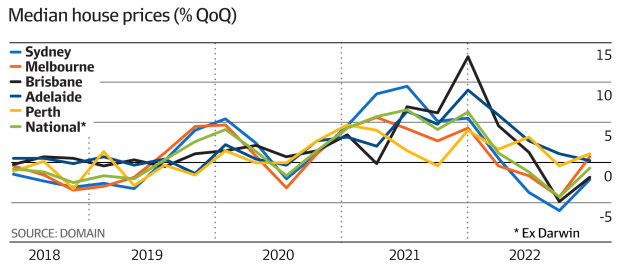The increase in Australia’s population – expected to be about 435,000 in 2022 – will also boost demand in pockets of the housing market, primarily in Sydney and Melbourne.
Gareth Aird, head of Australian economics at the Commonwealth Bank, the nation’s largest lender, said stronger population growth would partially offset falling property prices, largely due to the upward pressure on rents, but ultimately the biggest determinant was still going to be the path of the cash rate.

Unlikely to bottom until September
House prices are no longer plummeting at a record pace in Sydney, Brisbane and Canberra, and have stabilised by posting small increases in Melbourne, Adelaide and Hobart. Meanwhile, Perth and Darwin recorded gains in December, reversing declines in the September quarter.
But the housing market is unlikely to bottom out until around September, when some economists believe the central bank could begin cutting interest rates to buoy a struggling economy.
Domain’s chief of research and economics, Nicola Powell, said the housing market downturn had lost significant momentum over the past three months.
“This suggests that the peak rate of the quarterly decline has passed, as the September quarter bore the brunt of the initial shock of rising interest rates and exorbitant inflation levels causing house prices to fall at the fastest quarterly rate on record,” Dr Powell said.
“Buyers have had time to adjust to the new norm of the rising and higher cost of debt, mindful of their reduced borrowing capacity and future-proofing budgets.”
House prices in Sydney fell by 2.1 per cent in the December quarter, three times slower than the 6 per cent decline they recorded in the previous three months.
Brisbane dropped by 1.8 per cent, which is less than half the 4.9 per cent fall of the previous quarter.
Melbourne managed to recoup a sixth of the 4.3 per cent drop it posted in the previous quarter, with prices edging marginally higher by 0.7 per cent.
Adelaide, Perth, Hobart also returned to positive growth, with prices rising by 0.2 per cent, 1.1 per cent and 0.6 per cent respectively.
Darwin was the top-performing capital after notching a 3.3 per cent rise in the past three months.
“The flow of new supply has been unseasonably weak throughout spring and early summer,” Dr Powell said.

“Prospective sellers have been sitting on the sidelines, delaying decisions to see how the housing market downturn unravels and how high inflation and interest rates land.
“This low flow of new supply is a key factor keeping overall supply more stable against the backdrop of fewer sales, thereby helping to place a floor under prices.”
Strong argument for the RBA to pause
Despite the slowing rate of quarterly falls, house prices in Sydney and Canberra have posted their steepest annual decline in those cities’ history, falling by 10.9 per cent and 6 per cent respectively.
Melbourne and the combined capitals notched up the largest annual house price decline in over three years, falling by 5.6 per cent and 5 per cent respectively, while Brisbane racked up 1.1 per cent drop in the past year, the biggest annual drop in a decade.
By contrast, Adelaide and Perth were the only capitals hitting record high house prices over the year, with values jumping by 10.2 per cent to $783,705, and by 5.7 per cent to $658,270 respectively.
AMP Capital chief economist Shane Oliver said there was a strong argument for the RBA to pause rates in February, but even if it did, prices would likely keep falling.

“There’s still a flow through of the previous rate hikes, so my base case is for prices to continue falling by around 1 per cent nationwide each month through the second half of the year before slowing down further,” Dr Oliver said.
“History tells us in the last few cycles that we didn’t actually start seeing house price rises until interest rates were cut, so a pause in interest rate rises won’t be enough to spur price recovery.
“There is still a risk that the pace of decline could really accelerate again, if the RBA keeps raising interest rates that will risk a recession, and if there’s a pick-up in distressed sales once the majority of fixed term mortgages expire later this year.”
Unit prices in Sydney, Perth, Canberra and the combined capitals also posted a slower rate of decline, falling by 1.2 per cent, 0.4 per cent and 3.1 per cent respectively. During the September quarter, Sydney unit values dropped by 3.1 per cent, they were down by 2.4 per cent in Perth and by 4.2 per cent in Canberra.
Melbourne units have stabilised, recording only a small decline of 0.2 per cent. However, the rate of decline has accelerated in Brisbane and Hobart, dropping by 1.2 per cent and 3.1 per cent respectively.
Melbourne unit prices have dropped by 5.8 per cent over the year, the fastest annual decline in the city’s history, while Canberra fell by 3.7 per cent, which is the sharpest fall since 1997.
Unit values tumbled by 3.4 per cent in Hobart, the steepest drop in more than six years, while Sydney and the combined capitals notched up are in the largest annual unit price decline in over three years.
Bagikan Berita Ini














0 Response to "Sydney house prices: House prices are no longer falling at record speed: Domain - The Australian Financial Review"
Post a Comment